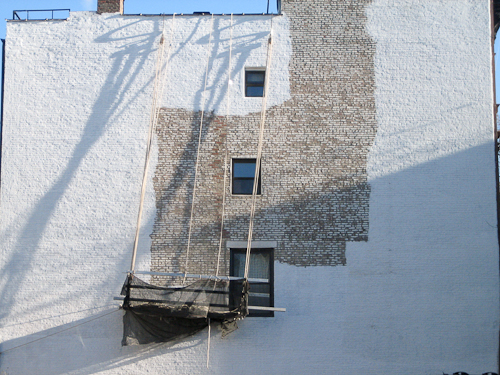Laughing and cursing

Across the street they're almost finished with the wall. I've been watching the progress. The other day the light and the shadows and the workers chatting and laughing and shouting at each other suddenly brought to mind a passage from one of my favorite books of the last several years: David Lewis-Williams, The Mind in the Cave.
Actually, the first thing that came to mind was Gregory Curtis' The Cave Painters. Curtis speculates, in his book, about the place and purpose of pictures within culture, and he quotes from Lewis-Williams to his illustrate his meaning. As it happens, the idea from Lewis-Williams that resonates so strongly with Curtis also resonates with me, and has done so ever since I read The Mind in the Cave five years ago. Here it is:
What is the meaning of the hand marks? Perhaps that's the wrong question. Instead, perhaps the question should be: what is the meaning of the paint?

Whether you're familiar with the cave paintings in Western Europe or not, you're probably familiar with this kind of negative image mark. Careful observation shows that the ancient painters made these marks by placing their hand on the rock and then blowing paint from their mouths to cover the surface of both the hand and the surrounding rock face; then, on removing their hand from the rock, its outline remains visible in the negative image, that is, in the rock that remains bare of paint. (This picture comes from an installation in the art education section of the Brooklyn Museum.)
Scholars have speculated for decades about the meaning of the cave paintings in general, and about the meaning of these negative image hand marks in particular. Lewis-Williams turns that speculation upside down in a beautiful and powerful way. Instead of focusing on the image of the hand that results from the paint-blowing, he says, let's think about the activity of the paint-blowing. Based on other observations in the caves, it could be that the painting process itself was the purpose, and that the resulting image was just a by-product. When the ancient man (or woman, or child - there are examples from all, including examples of hands touching and holding other hands) blew the paint out of his mouth - a metaphorical "breath" - the surface of hand and rock were unified underneath the surface of the paint. In this way the flesh merged with the material of the world and gave the human being access to a deeper experience of being in communion with the world. Lewis-Williams writes:
It seems that the answer to this question (of the meaning of the hand prints) has more to do with touching the rock surface than with image-making. In the case of negative prints, the paint was applied in such a way that...the hand thus 'disappeared' behind a layer of paint; it was 'sealed into' the wall.
The power of this formulation has come back to me, suddenly, in a cascade launched by this wall across the street.
When I teach photography, we talk about the visual process and the machine and the way the frame creates a picture, but we also talk about the activity of photography itself, about how photography engages the world. People come to class wanting to know how to use the camera or the computer, which button to push, which preference setting to use, and I try to persuade them they might be missing the point, that being a photographer is about the conversation, the activity, about scraping up against the material of the world and sparking ideas from the friction of living. The picture is a nice souvenir of the process, but it's not the whole point of the process.
Yesterday, standing on the street, watching these guys sweat and swear and laugh in the cold, it hit me, somehow, thoughts and emotions gelling unexpectedly and without warning, that what we do today with cameras is part of human history and has been since we began to call ourselves human. The community, the touch, the wall: it's in the paint, the emulsion, the ink. It's the laughing and cursing that counts. When we focus on the residue, the frame, the picture, as we do sometimes, obsessively, we risk missing the point entirely: picture-making is about living together.
As an afterthought: perhaps Garry Winogrand was completely correct.

He said, famously, "I photograph to see how things look photographed" (which has always tickled my sense of circularity), but when he died he left thousands of rolls of film undeveloped. It turned out that for years he had been photographing and not even processing, much less looking at, the pictures. I remember being so puzzled when I first encountered this little fact, and again when being reminded of it from time to time - especially at the giant retrospective put up a few years ago at the Center for Creative Photography, in Tucson, where the Winogrand archives are housed. Perhaps it's not too much to suggest that what Winogrand actually meant was, "I photograph to become more human."
To learn more about the cave paintings and the state of the current research into their meaning and preservation, see Judith Thurman's excellent article in the New Yorker.

Comments